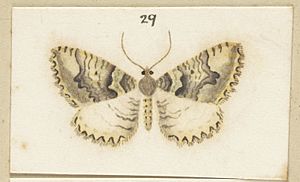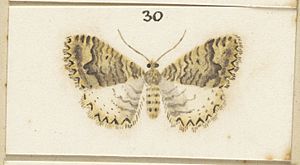Austrocidaria prionota facts for kids
Quick facts for kids Austrocidaria prionota |
|
|---|---|
 |
|
| Male | |
 |
|
| Female | |
| Scientific classification | |
| Kingdom: | |
| Phylum: | |
| Class: | |
| Order: | |
| Family: | |
| Tribe: |
Xanthorhoini
|
| Genus: |
Austrocidaria
|
| Species: |
A. prionota
|
| Binomial name | |
| Austrocidaria prionota (Meyrick, 1883)
|
|
| Synonyms | |
|
|
The Austrocidaria prionota is a special kind of moth. It belongs to the Geometridae family, often called "geometer moths" or "loopers." This moth lives only in New Zealand, which means it is endemic there. You can find it in the South Island, but it is quite rare.
Contents
Discovering the Austrocidaria prionota
This moth was first described by a scientist named Edward Meyrick in 1883. He found specimens (samples) of the moth near Castle Hill and Dunedin. Meyrick first gave it the name Arsinoe prionota.
Over time, scientists learn more about animals and sometimes change their names. In 1886, Meyrick realized the genus name he used had already been taken. So, he changed the moth's genus to Anachloris. Later, in 1917, he grouped Anachloris with another genus called Hydriomena.
George Hudson, another important entomologist (insect scientist), included this moth in his books. He showed pictures and descriptions of it in his 1898 and 1928 books, calling it Hydriomena prionota.
Finally, in 1971, J. S. Dugdale placed this moth into the genus Austrocidaria. This is the name it still has today. Dugdale also wondered if A. prionota might be the same species as another moth, Austrocidaria lithurgia.
What Does This Moth Look Like?
George Hudson described the Austrocidaria prionota moth in his books. He said its wings spread out to be a little less than 1.5 inches wide.
Forewings
The front wings (forewings) are a dull yellowish-brown color. They have many faint, wavy, brown lines that go across them. These lines often form two unclear bands. One band is narrow and close to the base of the wing. The other band is much wider and is found near the middle of the wing.
Hindwings and Other Features
The back wings (hindwings) are a very pale yellowish-brown. They have a few faint dark lines near the part of the wing closest to the body. The veins (lines on the wings) have clear black dots. The edges of all the wings are deeply scalloped, meaning they have a wavy, uneven shape.
This moth can look a bit different from one individual to another. It can also be confused with another similar-looking moth, Austrocidaria cedrinodes. However, you can tell them apart easily. The A. prionota moth does not have any "pectinations" (comb-like structures) on its antennae.
Where Does This Moth Live?
The Austrocidaria prionota moth is endemic to New Zealand. This means it is found naturally nowhere else in the world. It lives in the South Island.
Scientists have found this moth in places like Gouland Downs in Kahurangi National Park. It has also been collected in Castle Hill near Christchurch and in Dunedin. This moth is considered uncommon. It has been hard for scientists to find enough good specimens to add clear photos of it to their databases.
Life and Habits of the Moth
What Do They Eat?
The young moths, called larvae (caterpillars), have been seen eating certain plants. They feed on Myrsine divaricata and different types of Coprosma plants.
When Are They Active?
Adult Austrocidaria prionota moths are usually seen flying in January and October.
How Do They Fly?
This moth is considered a medium-level flyer. It can stay active even when there are light breezes. Adult moths are attracted to light. Scientists have collected them using special "Robinson light traps," which use light to attract insects.

